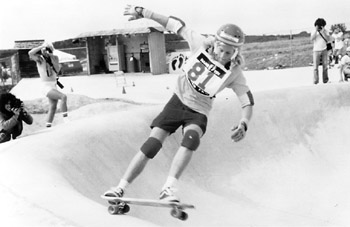![[Metroactive Movies]](http://metroactive.com/movies/gifs/movies468.gif)
[ Movies Index | Show Times | Silicon Valley | Metroactive Home | Archives ]
Chairmen of the Board
The exciting 'Dogtown and Z-Boys' chronicles the history of skateboarding
By Richard von Busack
STACY PERALTA'S Dogtown and Z-Boys has caught the ambience of a lost time and place, and that would seem even better than chronicling the beginning of a worldwide sport. To those who'd mainly thought of skateboards as a blessing for orthopedic surgeons, this documentary captures the excitement of skateboarding. The film provides an introduction to the popular sport, and it is more popular than we realize: its equipment sales exceed those of baseball.
Since I'm not getting any of that money, what fascinates me is the footage of what director Peralta calls "the last seaside slum." He means that no-man's-land strip of Ocean Park between Santa Monica and Venice, Calif., as it was in 1975. The area's biggest landmark was the burnt-out ruins of Pacific Ocean Park: "Where the debris meets the sea." Daredevil surf fiends would smuggle their boards past the Keep Out signs and shoot through the water around the splintery timbers and rusty iron of what was left of P.O.P.
These surfers were territorial, defending this wreckage with rocks, bottles and other projectiles--Vals Go Home! Across the street from this mess sat the Zephyr surf shop, where designer Jeff Ho installed some funk into the art and patterns of the boards. Soon after came the Zephyr surf team--the "Z-boys" of the title.
The problem with surfing in Santa Monica Bay is that the wind comes up between the morning and evenings; to pass the time, these surfers would practice their moves on the newly revamped skateboards of the mid-1970s.
While skateboards were around in the 1960s, as Peralta demonstrates, the new plastic-derived wheels were a technological improvement on the cruder ceramic wheels, which would crack, lock and break. The traction of the improved skateboards allowed more play. These surfers--of whom many were denizens of the beat-up coastal zone they nicknamed "Dogtown"--began to exhibit a new high-flying style.
This aerialism was promoted by photographer Glen E. Friedman in the pages of Thrasher magazine and debuted at the Del Mar national skateboarding competitions in 1975. There, a group of demure suburban skaters met the future of skating in the form of the Dogtown Boys--"like a hockey team going to a figure-skating show."
Maybe only Peralta, who was there in '75, could have gotten these interviews from a lot of wary skaters who are middle-aged men now. But that doesn't give the director enough credit for the slaved-over, densely layered surface of this documentary.
Peralta uses satellite photos to pinpoint the different elementary schools where the best ramps were located, and he cuts still photographs into vintage motion-picture films of the skaters in flight. Since he's describing a kinetic sport in which the best performers can cut loose from gravity, the editing never seems like pointless flash. The smash-and-grab imagery feels right for a group of kids seen, as they thought they were, in an eternal "now."
And the soundtrack is more evocative of mid-'70s L.A. than anything yet. We hear Neil Young's "Old Man," an inescapable bummer of the time reminding all who listened that if things seemed bad now, just imagine how terrible they'd be when you were old. (Appropriately, Peralta uses the tune to underscore the story of Jay Adams, one talented skater who ended up lost by the wayside.) And the arpeggios of David Bowie's "Aladdin Sane" sound like a depressed skater's waltz for the teenagers wheeling around on a long-ago afternoon.
A movie is automatically less interesting when it's all about the members of only one sex. If it weren't for Ho's ex-wife, a talented skater, all the interviewees would be male. Most of the women we see are faceless girls hanging around the sides of drained pools watching their boyfriends going around and around and around. (Length's the single biggest problem with Dogtown and Z-Boys; most of the film is for everybody, but it's prolonged to slake the appetites of the skate-crazed viewers.)
When talking about the roughness of Ocean Park, the narration mentions most of the kids were from "broken homes." In that time and that place, the phrase "broken home" would have been considered a mealy-mouthed joke, merely because there were so few homes around that weren't "broken."
This exaggeration of how bad Dogtown was seems characteristic of the film's narrator, Sean Penn, who, while a local, always tends to exaggerate his badass roots. However, Dog Town and Z-Boys is rousing fun, showing the ability of young people and artists alike to pull miracles right out of the asphalt.
[ Silicon Valley | Metroactive Home | Archives ]
Copyright © Metro Publishing Inc. Metroactive is affiliated with the Boulevards Network.
For more information about the San Jose/Silicon Valley area, visit sanjose.com.
![]()

Rim Shot: Stacy Peralta shows off his mid-'70s form.
Dogtown and Z-Boys (PG-13; 90 min.), a documentary by Stacy Peralta, opens May 3 at Camera 3 in San Jose and the Aquarius in Palo Alto.
Send a letter to the editor about this story
.
From the May 2-8, 2002 issue of Metro, Silicon Valley's Weekly Newspaper.